there
were three boys, friends since schoolyard days. Like it often happens with
such trios, the roles were determined from the start: the leader, the one who
is most mature while also being the craziest, then the reasonable and reliable
henchman, and then, later, the brilliant imp, a little perverse, the one who
can go farther than the others but who, out of fickleness or carefree
attitude, prefers to be seen as the one drawing the strings. He won't fool
anybody. Robert, Laurence and Simon, because they're the ones we're talking
about, had decided to make music and, under the name of Easy Cure, started a
rock group that had nothing to do, at that time, with the Pistols or The Clash
and even less with the others: Crass, Vibrators, U.K. Decay, Exploited etc. It
must have been hard enough to cure themselves of those kinds of music, since
quickly the group changed its name to just The Cure. Let's go quickly over the
trials and tribulations that a band can go through in ten years (The Cure
dates back to 1976), the paroxysms reached in in 1982 with the album
Pornography, the tour following this album, when the exacerbated feelings
of these three "imaginary boys" put them on edge, a crisis (that we could see
a reflection in Paris over two days at an Olympia hall full to the rafters and
infernally hot that made even veteran "rock critics" flee) whose only solution
was Simon's departure, divorce, separation, and everyone went their own way,
phew! it was too much. In the meantime, the trio had built what has now become
a legend, that their innumerable fans of today call The Iced Trilogy:
Seventeen Seconds, Faith, Pornography, three infernal records where the
listener, like the musician, attains the peaks of horror/splendor.
One
could have said then, in a vulgar jargon, that the group had split. But it
wasn't that, and it would have meant to have a poor idea of Robert's obstinate
personality (Taurus) and the steel-hard willpower under his Cheshire Cat
appearance. He understood that inaction would sign the death of the group and
so, with Lol, took timely actions such as performances, improvised concerts
and the single Let's Go To Bed. As if that wasn't enough, he became
guest guitarist for the somber Queen of the Night, Siouxsie Sioux, whose
tyranny he humbly accepted (it was one of the greatest periods of the
Banshees), without forgetting the unforgettable The Glove. From 1982
to 1985, The Cure was composed of Lol and Robert, the other musicians, despite
their talent, making just guest appearances.
Let's Go To Bed was an exorcism: a phantasy to root out the despair of
the Trilogy. Robert had understood, looking for instance at one of his
favorite groups, Joy Division, that one cannot venture with impunity into the
icy fields of fear and anxiety, and that the list of the dead, that
illustrates it unfortunately and needlessly, needn't grow longer: Let's Dance.
The
Walk / The Upstairs Room, the single that would follow, recorded in
Paris, manages to cut off The Cure from its fans up to then. Under the easy
attributes "commercial" or "silly", many would abandon the group just as, more
than ever, it needed support.
What
followed is known by everyone: more singles, then The Top, then
Simon's return after some wanderings with a clone group, and the splendid
The Head On The Door, symbol of Robert Smith's tenacity, perseverance and
self-confidence, his stubborn work so that HIS group, THE CURE, would be
indeed the cure against evil and sickness, for Hope against adversity, and
finally for Love and Happiness.
August 1986. Of all tours that The Cure has done throughout the
world: United States, Australia, etc., it is this French four-date tour that,
for us curists, will count as the most beautiful yet. Far from the too
gigantic Bercy show where twelve thousand people were acclaiming them, Dax,
Beziers, Frejus and Orange will inscribe in golden letters the beginning of
the great legend of The Cure.
Dax,
where the tour started, in almost intimate venues, is a "curists' town" in the
proper sense, with mud baths, mineral waters, and gentlemen and ladies of a
certain age and grand elegance rubbing shoulders around the Splendid [hotel].
It is here, in this fabulous art-deco hotel, resembling an ocean liner from
some musical, that this group of young and very British men and women are
starting their French journey, and it is here that I rejoined them after
dinner in the big dining hall. Almost at once, small cars (no limousines here)
pick them up and take them into the arena where they will make their
preparations. Radio Dax Ocean is there, as well as the photographer Claude
Gassian who will be, along with L'Equerre, the only representative of the
national press. It will be this evening that, for my part, I will take the
black and white photos published on these pages. As for the concert, opened
with Shake Dog Shake, it will continue, from Charlotte Sometimes through Kyoto
Song, without problems and receiving a very enthusiastic reaction.
Beziers,
which had almost the same conditions, passed equally without trouble.
Frejus;
from the whole coast, the young people in black converge towards the arena.
Fifteen thousand at least invade this city which, overnight, takes up an
unsettling air of mourning. The locals as well as the summer tourists watch,
flabbergasted, these somber hordes attacking their city that has seen
others... but not like these. Surprise before the show, Chris Parry, the
group's manager, announces an opening act: a percussion group invited by The
Cure.
It is in
ORANGE though that I will spend all my film before, during and after the show,
as well as receiving some definitive words from the very mouth of Mad Bob.
To start
with, the place is fabulous. We are already in Provence, a country directly
linked with the Antiquity, Rome and Athens. The city is quite ordinary aside
from the superb triumph arch, lit up at night by... orange lights. The Theatre
Antique can accommodate eight thousand people in front of a colossal wall made
of gigantic stones eroded by time. From twenty-five meters up, in a niche,
watches a giant statue of Emperor Augustus. I had gone by their hotel in the
afternoon but didn't find anybody save for one fiendish fan who follows The
Cure as if on a hunt, by taxi, hitching rides or on foot, in this infernal
heat, all covered in purple and black scarves and wool coverings, and who had
taken up camp in the small village where this castle-hotel rises. Leaving
behind this unfortunate, who had yet to make a show of herself, as in a
comedy, through some hyper-non-cool blunders, I descend towards Orange where I
arrive during the soundcheck.
Like all
backstage areas, the one this evening is divided into a "technical" area for
the operators, roadies, and catering, and a very protected area for the band
and its guests. Tonight, the atmosphere is even more charged than usual, since
a camera crew directed by Tim Pope has to film live, necessitating more
organizational work, and doubling the already considerable number of the Cure
staff. Besides, the band is going to have dinner in the common room after the
soundcheck, which will increase the nervousness by more than a little. I find
at the table Vivien Savage, the singer, with gypsy features and big brown
tresses, whom I had already met at the Bercy. He is one of the biggest fans of
The Cure, and knows their songs by heart: after the concert, he will have
emotional words to express the profound originality of this group that doesn't
owe anything to anyone. Select press representatives are also there, aside
from L'Equerre - the Salut newspaper with a photographer and a (charming)
reporter. It is the latter who tells me that, earlier that same day, Robert
had bought L'Equerre, together with Paris Match, at a service station. Salut
and their photographer will take some photos on the theatre stands and then
leave before the concert to catch the TGV (super-express train) to Paris.
In the
meantime, the crowd has started to fill the theater. It is still daylight, but
a sumptuous sunset illuminates the arena that has seen as many gladiator
fights as Sophocles tragedies or, more recently, operas by Wagner or Mozart.
And this is going to be a different sort of fight, opera or tragedy that we
are going to see tonight, since, from the first notes, with exceptional
acoustics and without a puff of the mistral wind that sometimes carries the
sound too far, we all feel that a sacred current is passing through, that the
music of The Cure has found here an inimitable setting, that the emotional
charge has found a communion both in the pain and the hope they carry within
them. How to describe the vibrant audience, the eternally lit-up lighters, the
pogoing fans in the first rows, the girls with dark lips holding their
crucifixes during One Hundred Years, the entire poetic potential of
eight thousand young people together this Saturday, 9th August, day of
St.Amour (!), four days after the full moon? From this bewitched audience will
rise sparklers and fireworks, and cries of ecstasy: the warmth of the night
blending with the perfection of the music, culminating into a 10:15
Saturday Night (was it really played at 10:15 that Saturday?) completely
evoking interplanetary travel as well as the most schizophrenic
introspection. A wonder. Bravos, cheers, encores, return backstage through
corridors carved through the gigantic walls.
After a
lot of difficulty trying to get access, I find our five heroes in the sanctum
sanctorum of the backstage area, still exhausted, surrounded by their
girlfriends and always watched over by Chris Parry, attentive manager who
brings the champagne that will relax the atmosphere. The place recalls a
little a tent in the desert: to the left of the entrance there is a simple
buffet, but for whom? since they don't let anyone enter - only the chief
editor of Melody Maker and his photographer, whom I would be meeting again the
next day. There are some cushions and chairs. Robert, as if by chance, is
sitting on the floor and represents, whether he wants it or not, the center of
this assembly. Next to him, a young man I've never seen before. He tells me,
to my great surprise, that he is Robert's cousin, which the latter will
confirm - only to tell me the contrary the next day! Everyone is still very
nervous - this infernal concert, the film crew, the heat. I get a shower of
champagne on my back when Chris Parry opens the first magnum (there will be
only two, let's be fair) and serves Robert first. The silence is almost
complete, aside from a few whispers, a few short conversations that seem more
an effort to fill the atmosphere than a real necessity. However, Robert Smith
has picked up the bottle to serve those around him with the delicate
thoughtfulness to start with me; we enter then into one of those
spatio-temporal aspects where time becomes an abstract concept for here he is
(Smith), engrossed in one of those incomprehensible conversations with the
people on this left. He puts down the bottle and seems to forget about it. I
offer to continue to serve but then I get a whole series of protest from him,
like "Ah yes, this is what I'm supposed to do, I will do it", and, despite the
others' protests, and mine in particular, such as "No, you don't really
have to do the service", he serves a full round.
A bit
later, I thank him for having bought L'Equerre that afternoon, which makes him
think of asking for explanations about the Curemania column. It has to be said
that Smithy has a sacred horror of anything that can look, from up-close or
from afar, like a fan club, and I had to reassure him about that. In no way is
L'Equerre the reflection of uncontrollable fanatics; it's rather the opposite,
I added: the group's admirers were starting to turn away because of its too
big success. "Ah yes", said Smith, "the reaction is starting", and I explain
that the early adopters are feeling overwhelmed. "They are snobs", Robert will
say, and it won't be the first time he's said it... and he's right, sorry for
those who like to look down their nose at the newcomers.
To
change the subject, I talk with him about the concert and the extraordinary
feeling I had during 10:15. Then, he lances into a completely
smithian monologue, addressed to me at first, but then he turns towards Mary
who is sitting in front of us. Mary is dressed all in white, in clothes with a
Hindu air: t-shirt robe over long, wide pants and high heels. She actually
evokes one of those beautiful Anglo-Orientals from James Ivory movies, with
her very luminous skin and big black eyes on a face like a Persian miniature.
Robert is in the middle of explaining to her the feelings that he had while
playing that famous 10:15: "I was going higher, it was so strange, I
was feeling so many things rushing over me and it was like... like..." During
these explanations and analyses, hermetical for those who don't speak
smithian, Mary keeps looking at him, drinking his words with the air of
entirely understanding him. Before those eyes, so eloquent and besides so
beautiful, Smith falls silent, stops and dives into Mary's eyes, just like she
dives into his. The stay like this for an eternity, looking at each other,
until I try a silly Americanism like "Don't tell me you're in love, nobody
will believe you!" but this joke, instead of causing a smile or the polite
embarrassment that an unskillful compliment can bring, on the
contrary provokes a reinforcement of the almost religious atmosphere caused by
their shared look. They contemplate each other with even more intensity (as if
that was possible) and Robert extends his hand towards Mary, who in turn
extends hers. The two hands join and stay together a very very long moment. It
is the emotional crowning of an evening where the artists, the public, the
countless technicians, security people and organizers have created one of
these celebrations whose image remains engraved into your memory, very
powerfully.
Cure, The Movie
A
deserted city, as if devastated by a hurricane. Empty cans and pink tickets
showing a smithian figure lie on the ground. A few survivors of a sleepless
night appear, like zombies.
It is on
this quiet Sunday, 10th August 1986, that at the Theatre Antique in
Orange takes place the filming of a few live shots that will be part of a Cure
film, produced by The Cure and directed by Tim Pope, already the author of
their delirious videos. This film that will include these live scenes as well
as others, filmed throughout the evolution and journeys of the group, will be
distributed globally... when it is finished.
We enter
the enclosure of the theater, perhaps one the most sublime and mystical places
that The Cure could ever play. Sitting comfortably on the stage in the company
of their girlfriends, the five musicians listen to the tape of yesterday's
concert, which had been filmed as well. On the subject of look, Robert has
chosen, since having his hair cut, a sailor cap that makes him look like he's
seventeen again. As for Simon, he's exchanged his usual black costume for some
savagely torn jeans showing some black lace tights very "sex and violence".
Simon and Porl are doing a hilarious belly dance to The Walk. Robert,
more composed, seems busy writing a song, while Lol and Boris seem more
interested in what's happening around them: the technicians are running
around, making preparations for the shoot. Meanwhile, Rob allows himself a
little break playing football with Chris Parry, the group's manager, and Steve
Sutherland, the chief editor of Melody Maker, looking very elegant in Indian
army shorts and tennis shoes. It is by the way Steve Sutherland whom the group
has asked to be in charge of the "official" biography of The Cure. Steve is
accompanied by Tom Sheehan, the magazine's photographer, for whom Robert and
Simon will make some irresistible faces.
Night
falls; there are individual soundchecks, and then the filming can start. The
Cure show up in stage costume: Robert wears a wig resembling his old hairdo;
it will be quickly torn off by Simon: ah, they're so funny, these dear kids!
Tim
Pope, who keeps pushing back his too long hair behind his ears (it makes you
want to hand him a rubber band to keep it) is bawling outrageously at our
star: "I will kick you if you do not move more!" The group interprets their
most beautiful songs in playback, but it is Inbetween Days that poses
the most problems: a split second on video necessitates a complicated movement
of the camera, while Tim Pope tries, for ten good minutes, to bombard Robert
with multicolored socks.
The
takes are exhausting and there's a little fifteen minute break between them;
this is why, before restarting, Smith passes an ice cube over his face to
simulate sweating, while hopping quickly around the stage four times!
The
filming of A Night Like This provokes hilarity as well: the speeded-up
playback version presents our five heroes playing in accelerated mode but
keeping all their dignity.
Another
pause (but not for everyone since neither the tech crew nor Tim Pope ever
stop), and Mad Bob descends from the stage to rejoin the girls (Mary, Cindy,
Janet, and Carol, looking like Barbie dolls) who had stayed very quietly in
the stands - like us - the whole evening to admire their men. Cindy comes
closer to the stage every now and then to film Boris with her Super 8 during
his drum solos. The Super 8 camera is actually one the favorite distractions
of the group, seeing that they spend practically half the day filming each
other.
Finally,
the hallucinatory shoot for Give Me It: Porl on sax lets loose Miles
Davis style, and Simon, unbridled, jumps at anything that moves, giving blows
with his bass all around him.
At three
in the morning, Tim Pope decides on an idea that we were hoping for from the
beginning: carved in the beautiful wall of this Gallo-Roman theater,
twenty-five meters above the stage, there is a niche where stands,
grandiously, Emperor Augustus, the first Roman emperor, Julius Caesar's
nephew. Under the frightened looks of their girlfriends, "My God, it's so
dangerous!", our five heroes pose around the statue in glamour poses, making
signs to a gathering that comprises just some V.H.F. (very happy few).
Finally, Rob, alone next to the statue, does a last dance step for us and a
last hand wave before finding himself again in Mary's arms. It is on this very
Beatles note (five boys in the wind) that this night ends, the last of the
summer 1986 tour.
In a
huge and sumptuous car, the Cure family takes the road back to the hotel, a
wonderful Provence castle. Their real vacations will start later in Mourillon.
Around Toulon and trips to Sainte Maxime among others one could see them at
the Groupie (!), a seafood restaurant, as well as in numerous bars in the
region. It is in this Mediterranean south that The Cure reside for now, and
record their new album. Like other British groups before them (Rolling Stones
for example), they find in France the success, the joy of life and the
beginning of glory.
Photo
legends (on page 9):
Around
the statue at 3am: from left to right, Porl, Robert, Simon, Boris and Lol.
Below:
Robert Smith
Below,
left: Tim Pope descending the steps, preceded by his camera, after the
shooting of the last scene.
A BIG BIG THANKS to: Aria Thelmann
for the TRANSLATION.

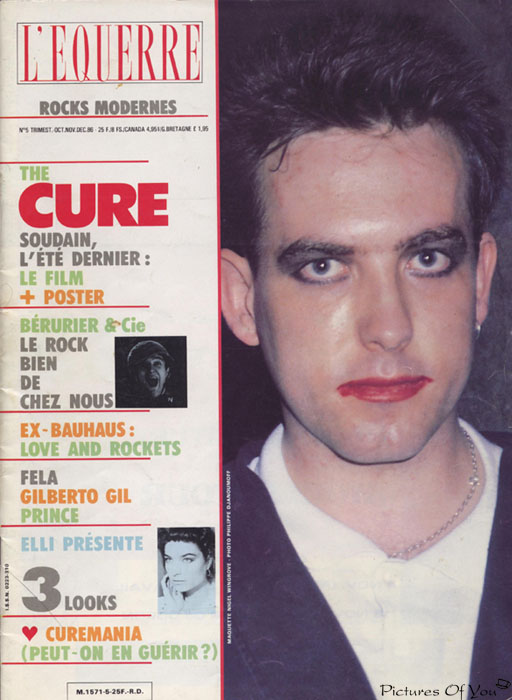
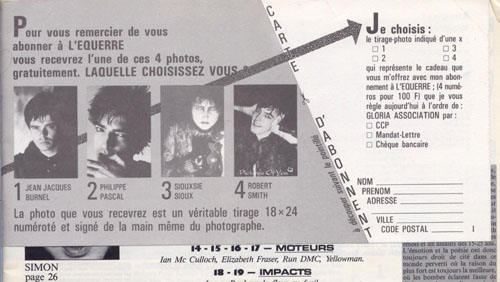 (order
this poster)
(order
this poster)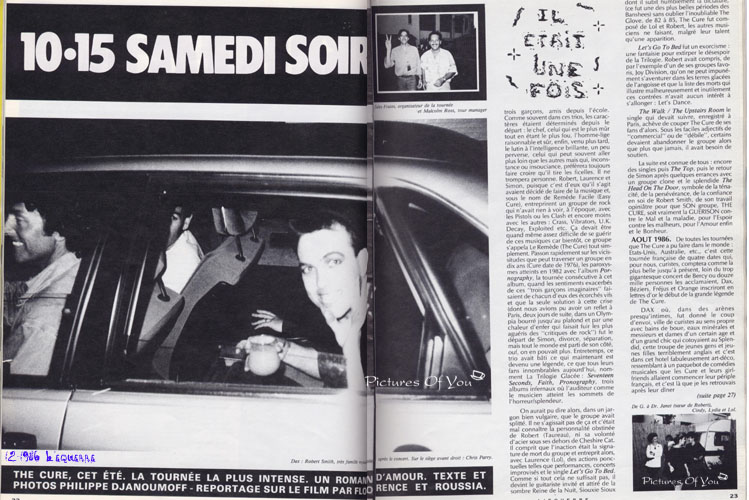
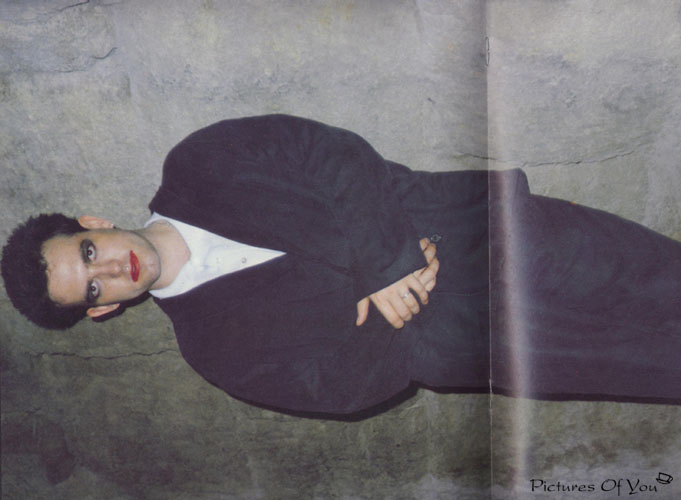
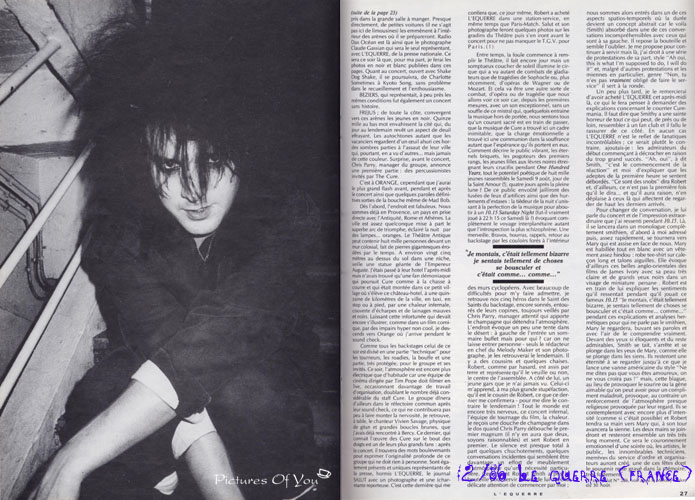
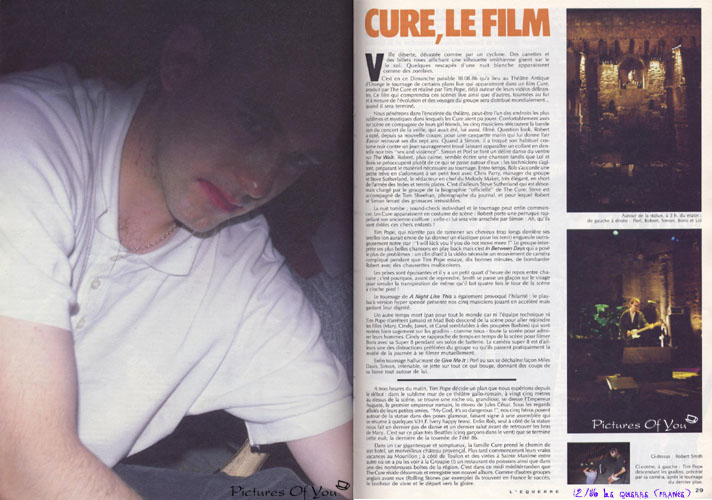
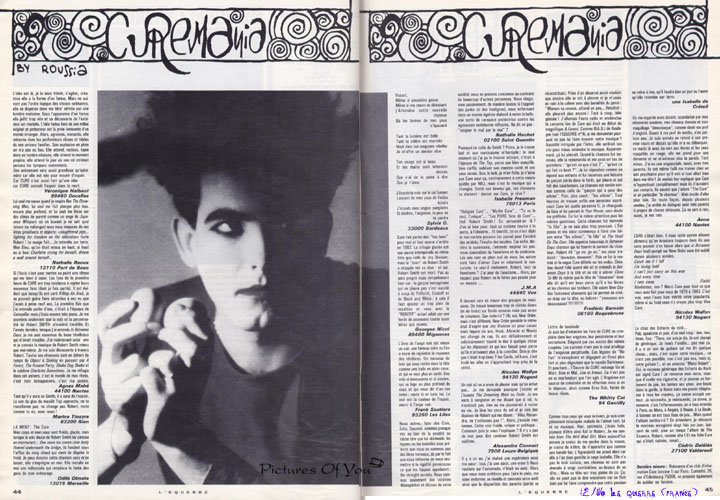

 (order
this poster)
(order
this poster)



